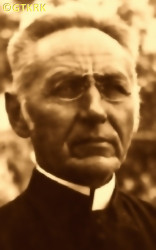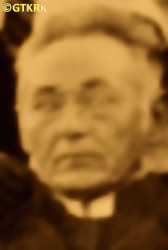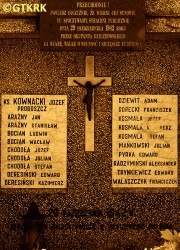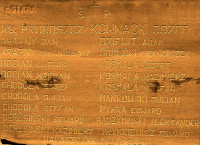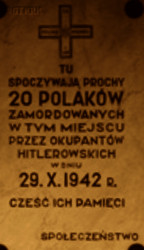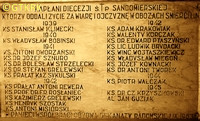Roman Catholic
St Sigismund parish
05-507 Słomczyn
85 Wiślana Str.
Konstancin deanery
Warsaw archdiocese, Poland
full list:
displayClick to display full list

searchClick to search full list by categories
wyświetlKliknij by wyświetlić pełną listę po polsku

szukajKliknij by przeszukać listę wg kategorii po polsku

Martyrology of the clergy — Poland
XX century (1914 – 1989)
personal data
surname
KOWNACKI
forename(s)
Joseph Benedykt Constantine (pl. Józef Benedykt Konstanty)
function
diocesan priest
creed
Latin (Roman Catholic) Church RCmore on
en.wikipedia.org
[access: 2014.09.21]
diocese / province
Sandomierz diocesemore on
en.wikipedia.org
[access: 2013.05.19]
date and place
of death
29.10.1942

Góra Puławskatoday: Puławy gm., Puławy pov., Lublin voiv., Poland
more on
en.wikipedia.org
[access: 2021.12.19]
details of death
In 1903, during the partitions op Poland, „arbitrarily” collected contributions for the reconstruction of the church house in Odrowąż.
The tsarist authorities, by the diocesan bishop of the Sandomierz diocese, „admonished him”.
On 07.11.1905, due to the martial law in the Russian Empire (Russo–Japanese War, etc.), the Governor General of Warsaw ordered him to be arrested and placed in a monastery in Obory.
The immediate cause was the blessing the banners with „revolutionary” inscriptions on 30.10.1905.
Due to the fact that martial law was ended at the same time, there was no detention in Obory.
But already on 26.01.1906, for public support of the postulate of teaching in schools in Polish, and for singing a „revolutionary” hymn in his parish in Smardzewice (i.e. „God save Poland!”), sentenced to prison by the Russian governor–general in Warsaw.
Went into hiding.
Pn 30.05.1906 however, arrested by the Russians and imprisoned in the Carmelite monastery in Obory.
From there, on 23.06.1906, escaped and hid in Łódź.
From there formally applied for a change of decisions.
For an answer prob. got detained — all his property was confiscated and was forbidden to reside in the entire territory of the Rus. Царство Польское (Eng. Kingdom of Poland), part of partitioned Poland administered by the Russians.
As a result on 26.03.1907 went to Kiev.
Numerous time petitioned the Russian authorities in Warsaw and Saint Petersburg for permission to return — to no avail.
In c. 1913 prob. without permission returned however to the Rus. Царство Польское.
In 1913 — holding no official church position — conducted a funeral in the Nowe Miasto parish in Warsaw, without permission.
The Russians were investigating, but stopped it. His name appears again in the books of the Sandomierz diocese only in 1916, after the outbreak of World War I and after the Russian defeat in the Battle of Gorlice in 05.1915, which led to the panic withdrawal of Russians from the Rus. Царство Польское to the east and the beginning of the German–Austrian occupation.
After German and Russian invasion of Poland in 09.1939 and start of the World War II, asked to be accepted into the Polish Army as a chaplain. Prob. did not obtain consent.
After start of German occupation, arrested for the first time by the Germans on 17.09.1940.
Jailed in Radom prison.
On 29.09.1939 released.
On 14.10.1940 arrested again. Prob. the reason was a letter sent to the German mayor of his parish's Góra Puławska, in which wrote, among other things, „Please do not scare me with prison, because a Catholic priest is not afraid of prison”.
Again jailed in Radom — initially in a solitary, dark cell — and again on 11.11.1940 released.
Finally in retaliation for execution of German confidents by Polish resistance fighters from Home Army AK (part of Polish Clandestine State) arrested on 03.10.1942.
Jailed in Radom prison.
Tortured.
On 29.10.1942 heavily beaten up (could not stand up on his own) brought back to Puławska Góra and hanged publicly together with 19 inhabitants of Góra Puławska — as the first one.
cause of death
mass murder
perpetrators
Germans
sites and events
RadomClick to display the description, GeneralgouvernementClick to display the description, Ribbentrop‐MolotovClick to display the description, Pius XI's encyclicalsClick to display the description
date and place
of birth
10.03.1874

Różkitoday: Kowala gm., Radom pov., Masovia voiv., Poland
more on
en.wikipedia.org
[access: 2022.01.28]
presbyter (holy orders)
ordination
28.11.1897

positions held
1931 – 1942
parish priest — Góra Puławskatoday: Puławy gm., Puławy pov., Lublin voiv., Poland
more on
en.wikipedia.org
[access: 2021.12.19] ⋄ St Adalbert the Bishop and Martyr RC parish ⋄ Zwoleńtoday: Zwoleń gm., Zwoleń pov., Masovia voiv., Poland
more on
en.wikipedia.org
[access: 2021.12.19] RC deanery
1919 – c. 1920
administrator — Odrzywółtoday: Odrzywół gm., Przysucha pov., Masovia voiv., Poland
more on
en.wikipedia.org
[access: 2021.09.29] ⋄ St Hedwig of Silesia RC parish ⋄ Skrzynnotoday: Wieniawa gm., Przysucha pov., Masovia voiv., Poland
more on
en.wikipedia.org
[access: 2021.09.29] RC deanery
1916 – c. 1917
administrator — Chotczatoday: Chotcza Dolna, Chotcza gm., Lipsko pov., Masovia voiv., Poland
more on
en.wikipedia.org
[access: 2021.09.29] ⋄ Holy Trinity RC parish ⋄ Iłżatoday: Iłża gm., Radom pov., Masovia voiv., Poland
more on
en.wikipedia.org
[access: 2021.09.29] RC deanery
1907 – c. 1913
priest — Kievtoday: Kiev city rai., Kiev city obl., Ukraine
more on
en.wikipedia.org
[access: 2023.03.02]
1906 – c. 1907
curatus/rector/expositus — Zemborzyn Kościelnytoday: Tarłów gm., Opatów pov., Holy Cross voiv., Poland
more on
en.wikipedia.org
[access: 2025.01.12] ⋄ St Nicholas the Bishop and Confessor RC church ⋄ Tarłówtoday: Tarłów gm., Opatów pov., Holy Cross voiv., Poland
more on
en.wikipedia.org
[access: 2022.12.25], Holy Trinity RC parish ⋄ Iłżatoday: Iłża gm., Radom pov., Masovia voiv., Poland
more on
en.wikipedia.org
[access: 2021.09.29] RC deanery
from 1903
vicar — Smardzewicetoday: Tomaszów Mazowiecki gm., Tomaszów Mazowiecki pov., Łódź voiv., Poland
more on
en.wikipedia.org
[access: 2021.09.29] ⋄ St Anne RC parish ⋄ Opocznotoday: Opoczno gm., Opoczno pov., Łódź voiv., Poland
more on
en.wikipedia.org
[access: 2021.09.29] RC deanery
1903
curatus/rector/expositus — Święty Krzyżtoday: part of Nowa Słupia town, Nowa Słupia gm., Kielce pov., Holy Cross voiv., Poland
more on
en.wikipedia.org
[access: 2021.09.29] ⋄ Holy Trinity RC church ⋄ Słupia Nowatoday: Nowa Słupia, Nowa Słupia gm., Kielce pov., Holy Cross voiv., Poland
more on
en.wikipedia.org
[access: 2021.09.29], St Lawrence the Martyr RC parish ⋄ Opatówtoday: Opatów gm., Opatów pov., Holy Cross voiv., Poland
more on
en.wikipedia.org
[access: 2021.07.18] RC deanery
c. 1903
vicar — Sandomierztoday: Sandomierz urban gm., Sandomierz pov., Holy Cross voiv., Poland
more on
en.wikipedia.org
[access: 2021.09.29] ⋄ Nativity of the Blessed Virgin Mary RC cathedral church
c. 1902
vicar — Połaniectoday: Połaniec gm., Staszów pov., Holy Cross voiv., Poland
more on
en.wikipedia.org
[access: 2024.12.13] ⋄ St Martin the Bishop and Confessor RC parish ⋄ Sandomierztoday: Sandomierz urban gm., Sandomierz pov., Holy Cross voiv., Poland
more on
en.wikipedia.org
[access: 2021.09.29] RC deanery
vicar — Odrowążtoday: Stąporków gm., Końskie pov., Holy Cross voiv., Poland
more on
en.wikipedia.org
[access: 2025.01.12] ⋄ St Jack the Confessor and St Catherine the Martyr RC parish ⋄ Końskietoday: Końskie gm., Końskie pov., Holy Cross voiv., Poland
more on
en.wikipedia.org
[access: 2021.05.30] RC deanery
vicar — Radoszycetoday: Radoszyce gm., Końskie pov., Holy Cross voiv., Poland
more on
en.wikipedia.org
[access: 2021.09.29] ⋄ St Peter and St Paul the Apostles RC parish ⋄ Końskietoday: Końskie gm., Końskie pov., Holy Cross voiv., Poland
more on
en.wikipedia.org
[access: 2021.05.30] RC deanery
vicar — Zwoleńtoday: Zwoleń gm., Zwoleń pov., Masovia voiv., Poland
more on
en.wikipedia.org
[access: 2021.12.19] ⋄ Exaltation of the Holy Cross RC parish ⋄ Kozienicetoday: Kozienice gm., Kozienice pov., Masovia voiv., Poland
more on
en.wikipedia.org
[access: 2021.12.19] RC deanery
1895 – 1897
student — Sandomierztoday: Sandomierz urban gm., Sandomierz pov., Holy Cross voiv., Poland
more on
en.wikipedia.org
[access: 2021.09.29] ⋄ philosophy and theology, Theological Seminary
1891 – 1895
student — Warsawtoday: Warsaw city pov., Masovia voiv., Poland
more on
en.wikipedia.org
[access: 2021.10.09] ⋄ philosophy and theology, Metropolitan Theological Seminary
sites and events
descriptions
Radom: The prison in Radom was established in 1817 by the Russian authorities (during partitions of Poland) and operated in the building of the former convent of the Benedictine Sisters. After the start of the German occupation in 09‐10.1939, Germans categorized the prison as a so‐called independent judicial prison, generally supervised by the Justice Department of the Government of the Germ. Generalgouvernement (Eng. General Governorate), and within the district — by the Justice Department of the Governor's Office of the District of Radom. It was called interchangeably Germ. „Gefängnis Radom” (Eng. „Prison in Radom”) and Germ. „Deutsche Strafanstalt Radom” (Eng. „German prison in Radom”). The prison had three departments: women's, criminal, German, and from the end of 1942, the Germ. „Sonderabteilung” (Eng. „Special department”) managed by the German political police Gestapo. During the World War II, c. 18,000 people — mostly political prisoners — passed through it (14,170 files of inmates have survived). At least several thousand were murdered or taken to concentration camps. The prison operated under German supervision until c. 15.01.1945 (the last transport sent to KL Auschwitz left on 14.01.1945 — it only reached Częstochowa, and the rest of the prisoners were murdered by the Germans). After the end of the military operations of World War II and the beginning of the Russian occupation in 1945, members of Polish independence organizations were held there. On 09.09.1945 armed underground units (Freedom and Independence WiN and National Military Organization NOW, consisting of former members of the Home Army AK, „Jodła” region — part of the former Polish Clandestine State) commanded by Stefan Bembiński „Harnas”, freed 292 inmates, including 60 former Home Army AK soldiers arrested by a unit of the Commie‐Nazi Security Office of the UB (subordinate to the Russian NKVD). (more on: www.polskaniezwykla.plClick to attempt to display webpage
[access: 2013.08.17])
Generalgouvernement: After the Polish defeat in the 09.1939 campaign, which was the result of the Ribbentrop‐Molotov Pact and constituted the first stage of World War II, and the beginning of German occupation in part of Poland (in the other, eastern part of Poland, the Russian occupation began), the Germans divided the occupied Polish territory into five main regions. In two of them new German provinces were created, two other were incorporated into other provinces. However, the fifth part was treated separately, and in a political sense it was supposed to recreate the German idea from 1915 (during World War I, after the defeat of the Russians in the Battle of Gorlice in 05.1915) of creating a Polish enclave within Germany. Illegal in the sense of international law, i.e. Hague Convention, and public law, managed by the Germans according to separate laws — especially established for the Polish Germ. Untermenschen (Eng. subhumans) — till the Russian offensive in 1945 it constituted part of the Germ. Großdeutschland (Eng. Greater Germany). Till 31.07.1940 formally called Germ. Generalgouvernement für die besetzten polnischen Gebiete (Eng. General Government for the occupied Polish lands) — later simply Germ. Generalgouvernement (Eng. General Governorate), as in the years 1915‐1918. From 07.1941, i.e. after the German attack on 22.06.1941 against the erstwhile ally, the Russians, it also included the Galicia district, i.e. the Polish pre‐war south‐eastern voivodeships. A special criminal law was enacted and applied to Poles and Jews, allowing for the arbitrary administration of the death penalty regardless of the age of the „perpetrator”, and sanctioning the use of collective responsibility. After the end of the military conflict of the World War UU, the government of the Germ. Generalgouvernement was recognized as a criminal organization, and its leader, governor Hans Frank, guilty of war crimes and crimes against humanity and executed. (more on: en.wikipedia.orgClick to attempt to display webpage
[access: 2024.12.13])
Ribbentrop‐Molotov: Genocidal Russian‐German alliance pact between Russian leader Joseph Stalin and German leader Adolf Hitler signed on 23.08.1939 in Moscow by respective foreign ministers, Mr. Vyacheslav Molotov for Russia and Joachim von Ribbentrop for Germany. The pact sanctioned and was the direct cause of joint Russian and German invasion of Poland and the outbreak of the World War II in 09.1939. In a political sense, the pact was an attempt to restore the status quo ante before 1914, with one exception, namely the „commercial” exchange of the so‐called „Kingdom of Poland”, which in 1914 was part of the Russian Empire, fore Eastern Galicia (today's western Ukraine), in 1914 belonging to the Austro‐Hungarian Empire. Galicia, including Lviv, was to be taken over by the Russians, the „Kingdom of Poland” — under the name of the General Governorate — Germany. The resultant „war was one of the greatest calamities and dramas of humanity in history, for two atheistic and anti‐Christian ideologies — national and international socialism — rejected God and His fifth Decalogue commandment: Thou shall not kill!” (Abp Stanislav Gądecki, 01.09.2019). The decisions taken — backed up by the betrayal of the formal allies of Poland, France and Germany, which on 12.09.1939, at a joint conference in Abbeville, decided not to provide aid to attacked Poland and not to take military action against Germany (a clear breach of treaty obligations with Poland) — were on 28.09.1939 slightly altered and made more precise when a treaty on „German‐Russian boundaries and friendship” was agreed by the same murderous signatories. One of its findings was establishment of spheres of influence in Central and Eastern Europe and in consequence IV partition of Poland. In one of its secret annexes agreed, that: „the Signatories will not tolerate on its respective territories any Polish propaganda that affects the territory of the other Side. On their respective territories they will suppress all such propaganda and inform each other of the measures taken to accomplish it”. The agreements resulted in a series of meeting between two genocidal organization representing both sides — German Gestapo and Russian NKVD when coordination of efforts to exterminate Polish intelligentsia and Polish leading classes (in Germany called «Intelligenzaktion», in Russia took the form of Katyń massacres) where discussed. Resulted in deaths of hundreds of thousands of Polish intelligentsia, including thousands of priests presented here, and tens of millions of ordinary people,. The results of this Russian‐German pact lasted till 1989 and are still in evidence even today. (more on: en.wikipedia.orgClick to attempt to display webpage
[access: 2015.09.30])
Pius XI's encyclicals: Facing the creation of two totalitarian systems in Europe, which seemed to compete with each other, though there were more similarities than contradictions between them, Pope Pius XI issued in 03.1937 (within 5 days) two encyclicals. In the „Mit brennender Sorge” (Eng. „With Burning Concern”) published on 14.03.1938, condemned the national socialism prevailing in Germany. The Pope wrote: „Whoever, following the old Germanic‐pre‐Christian beliefs, puts various impersonal fate in the place of a personal God, denies the wisdom of God and Providence […], whoever exalts earthly values: race or nation, or state, or state system, representatives of state power or other fundamental values of human society, […] and makes them the highest standard of all values, including religious ones, and idolizes them, this one […] is far from true faith in God and from a worldview corresponding to such faith”. On 19.03.1937, published „Divini Redemptoris” (Eng. „Divine Redeemer”), in which criticized Russian communism, dialectical materialism and the class struggle theory. The Pope wrote: „Communism deprives man of freedom, and therefore the spiritual basis of all life norms. It deprives the human person of all his dignity and any moral support with which he could resist the onslaught of blind passions […] This is the new gospel that Bolshevik and godless communism preaches as a message of salvation and redemption of humanity”… Pius XI demanded that the established human law be subjected to the natural law of God , recommended the implementation of the ideal of a Christian state and society, and called on Catholics to resist. Two years later, National Socialist Germany and Communist Russia came together and started World War II. (more on: www.vatican.vaClick to attempt to display webpage
[access: 2023.05.28], www.vatican.vaClick to attempt to display webpage
[access: 2023.05.28])
sources
personal:
www.mmpulawy.plClick to attempt to display webpage
[access: 2013.05.19], tpgorapulawska.plClick to attempt to display webpage
[access: 2014.08.14], bdsandomierz.plClick to attempt to display webpage
[access: 2025.01.12]
original images:
gimnazjumgp.plClick to attempt to display webpage
[access: 2019.10.13], gimnazjumgp.plClick to attempt to display webpage
[access: 2019.10.13], www.facebook.comClick to attempt to display webpage
[access: 2019.10.13], www.gminapulawy.plClick to attempt to display webpage
[access: 2014.08.14], www.jaroslawzaczek.plClick to attempt to display webpage
[access: 2014.01.06], www.youtube.comClick to attempt to display webpage
[access: 2024.12.13]
LETTER to CUSTODIAN/ADMINISTRATOR
If you have an Email client on your communicator/computer — such as Mozilla Thunderbird, Windows Mail or Microsoft Outlook, described at WikipediaPatrz:
en.wikipedia.org, among others — try the link below, please:
LETTER to CUSTODIAN/ADMINISTRATORClick and try to call your own Email client
If however you do not run such a client or the above link is not active please send an email to the Custodian/Administrator using your account — in your customary email/correspondence engine — at the following address:

giving the following as the subject:
MARTYROLOGY: KOWNACKI Joseph Benedykt Constantine
To return to the biography press below:
 Click to return to biography
Click to return to biography








